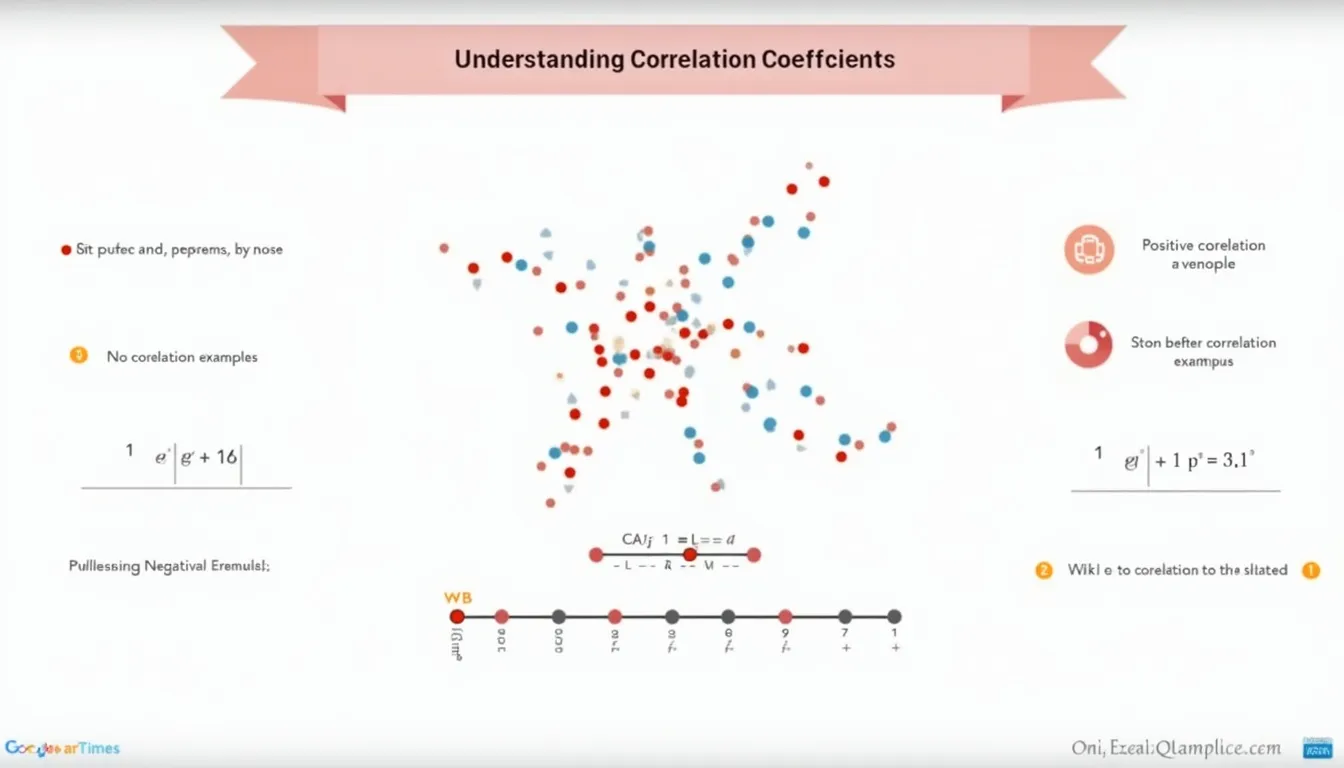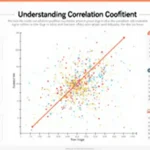Correlation Coefficient Calculator
Is this tool helpful?
How to use the tool
1. Pick an input method
- Manual – type comma-separated numbers directly.
- CSV upload – load a two-column file; column 1 = X, column 2 = Y.
2. Enter your data (two fresh examples)
Example A (strong positive)
- X: 4, 9, 11, 14
- Y: 8, 11, 14, 18
Example B (strong negative)
- X: 5, 6, 7, 8, 9
- Y: 20, 18, 15, 13, 11
3. (Optional) tick “Line of Best Fit”
The trendline clarifies the direction and steepness of the relationship.
4. Press “Calculate”
- The tool validates equal lengths and numeric input.
- It reports Pearson’s r, a plain-English verdict, and a scatter plot.
Behind the scenes – the math
Pearson’s formula:
$$ r = rac{n\sum xy – \sum x \sum y}{\sqrt{[n\sum x^{2}-(\sum x)^{2}]\,[n\sum y^{2}-(\sum y)^{2}]}} $$
Worked calculation for Example A
- n=4, Σx=38, Σy=51, Σxy=537, Σx²=414, Σy²=705
- Numerator = 4 × 537 – 38 × 51 = 210
- Denominator = √[(4 × 414 – 38²)(4 × 705 – 51²)] ≈ 215.47
- r = 210 / 215.47 ≈ 0.97 (very strong positive)
Quick-Facts
- Pearson’s r ranges from −1 (perfect inverse) to +1 (perfect direct) (NIST e-Handbook, https://itl.nist.gov/div898/handbook).
- At least two paired observations are required (Yale Stats, https://stats.idre.ucla.edu).
- |r| ≥ 0.7 = strong, |r| < 0.3 = weak (Mukaka 2012, PMCID:PMC3576830).
- Browser FileReader comfortably parses ~1 MB CSV in under 0.2 s on modern hardware (MDN FileReader, https://developer.mozilla.org).
- All processing happens locally; no data leaves your device (Mozilla Security Blog, https://blog.mozilla.org).
FAQ
What is Pearson’s correlation coefficient?
It quantifies how well two variables align linearly, yielding values between −1 and +1 (NIST e-Handbook, https://itl.nist.gov/div898/handbook).
How should my CSV be structured?
Place X values in column 1, Y values in column 2, no headers. Save as plain text with commas (RFC 4180, https://datatracker.ietf.org/doc/html/rfc4180).
What happens if the lists differ in length?
The calculator flags an error because Pearson’s r requires equal-sized pairs (Yale Stats, https://stats.idre.ucla.edu).
Can the tool spot non-linear patterns?
No—Pearson’s r only measures linear association. Use Spearman’s ρ or curve fitting for curves (Sheskin 2011, Handbook of Parametric Tests).
What does a negative r mean?
Negative values show that as X rises, Y falls. r = −1 is a perfect inverse line (NIST e-Handbook).
How many data points give reliable results?
Thirty or more pairs improve stability and significance testing (Central Limit Theorem; Montgomery 2020, Applied Statistics).
Is my data uploaded to a server?
No. All computations run in your browser with JavaScript; the file never leaves your device (Mozilla Security Blog).
How is the line of best fit drawn?
The script calculates slope and intercept via least-squares regression and renders a two-point line overlay (Hastie et al., Elements of Statistical Learning).
Important Disclaimer
The calculations, results, and content provided by our tools are not guaranteed to be accurate, complete, or reliable. Users are responsible for verifying and interpreting the results. Our content and tools may contain errors, biases, or inconsistencies. Do not enter personal data, sensitive information, or personally identifiable information in our web forms or tools. Such data entry violates our terms of service and may result in unauthorized disclosure to third parties. We reserve the right to save inputs and outputs from our tools for the purposes of error debugging, bias identification, and performance improvement. External companies providing AI models used in our tools may also save and process data in accordance with their own policies. By using our tools, you consent to this data collection and processing. We reserve the right to limit the usage of our tools based on current usability factors.







